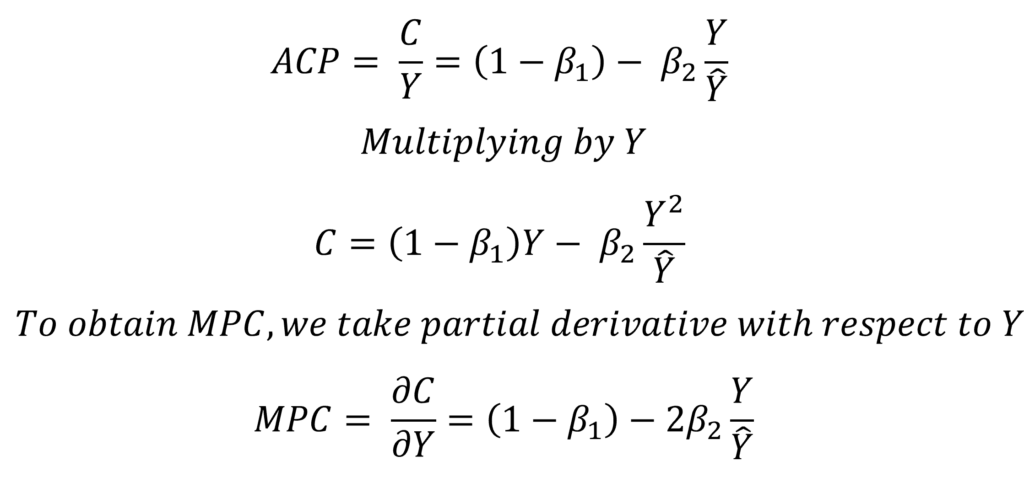Duesenberry took a different approach to develop a model explaining consumption behaviour. While other models such as the permanent income hypothesis are based on utility function independent of consumption by other individuals, this model considers utility as a function of relative consumption. That is, utility is maximized by considering the consumption levels of the rest of the population. Hence, it is known as the Relative Income Hypothesis.
Econometrics Tutorials with Certificates
utility function and relative consumption
According to Duesenberry, consumers are not concerned about absolute consumption. But, their consumption decisions are based on relative consumption in comparison to the rest of the population. Generally, utility is a function of the absolute quantity of goods (absolute consumption). However, relative income hypothesis proposes a slightly different utility function which can be stated as follows:

According to this utility function, there is a positive relationship between utility and relative consumption. This means that utility will increase when consumption increases relative to the average consumption of the population. Or, when the increase in consumption is greater than the increase in the average consumption of the population.
This approach can explain both cross-sectional and long-run behaviour of consumption observed in empirical studies:
MPC<APC across cross-sections
The above utility function implies that consumption decisions depend on income distribution in the economy. When a consumer has below-average income, he will try to match the average consumption level of the population. They will end up spending a larger proportion of their below-average income. As a result, APC (C / Y) will be high in the case of individuals with lower than average income. On the other hand, individuals with income higher than the average population income will spend a lower proportion of income on consumption because they can match average consumption by spending a lesser portion of income. Hence, high-income groups will have lower APC (C / Y).

With APC falling with higher income, MPC will be less than APC (MPC<APC) across different sections which explains consumption behaviour observed in cross-sectional studies.
MPC = APC in the long run
The economy will grow along the trend in the long run. With growth, the income of consumers will increase, however, the average income of the population will also increase along with it. Hence, relative income will still remain stable even with rising incomes because the income of the entire population increases which also shifts average income upwards.
Since relative income is still stable, there is no reason for the APC (C / Y) to change. It will remain constant as the economy grows along the trend line. As long as the relative distribution of income is stable, this hypothesis will hold true because growth in the economy will lead to a proportionate growth in consumption for all individuals.
Present consumption, past consumption and cyclical fluctuations
According to Duesenberry, past consumption also affects present consumption. Therefore, consumption in previous time periods along with current relative income help in determining current consumption. For individuals, it is difficult to reduce consumption in the current period after attaining a certain level of consumption in the previous time periods. It is easier for them to reduce their savings instead of consumption.
Duesenberry formulated this in terms of savings. It suggests that the savings to income ratio depend on the level of current income in comparison to the previous peak income (which is the highest previous period income). This relationship can be expressed as follows:

There is a positive relationship between the saving-income ratio and relative income. A rise in income relative to previous peak income leads to an increase in the saving-income ratio. Therefore, the proportion of savings increases with an increase in income relative to peak income. This savings function can be easily converted into a consumption function as follows:

As income grows along a trend over a long period of time, the previous peak income will always be the income from the previous year’s income. As a result, an increase in the ratio of income to peak income will be equal to the growth of the economy along the trend. If the economy grows by 5 per cent, this ratio will increase by 5 per cent as well. Hence, the ACP will be constant along the trend.
Cyclical fluctuations
Although ACP is constant along the trend growth, there are cyclical fluctuations around this trend due to business cycles. The ACP (C / Y) has a negative relationship with income because the coefficient (beta2) is negative.
The above equation can be used to estimate MPC:

If we compare both equations of APC and MPC, it is clear that MPC<APC. When the peak income is fixed, the MPC equation has a greater negative component as it multiplies the negative component by 2.
Therefore, we can conclude that MPC<APC in the shorter periods of business cycles when the APC falls with an increase in income. In the long run, however, APC is constant with growth along the trend.
the ratchet effect
The combination of short-run and long-run consumption explained by the relative income hypothesis gives us the ratchet effect. In the long run, the economy grows along the trend line shown by the long-run consumption function. The APC is constant in the long run. This means that the proportion of income spent on consumption remains constant because relative income is stable.

However, if the economy falls into recession and income decreases, short-run consumption moves on to consumption functions shown by CA and CB. On these short-run curves, APC falls as income rises during the recovery period till it reaches the long-run function or the trend. At that point, growth resumes at its constant APC after reaching the previous peak period of income. The MPC on these short-run curves can be estimated using the above equations and it will always be less than APC on the short-run curves CA and CB.
Criticism of Relative Income Hypothesis
The role of wealth or assets is not taken into consideration in the relative income hypothesis. But, wealth plays an important role in determining consumption levels. Although this theory provides a different perspective through relative income, theories such as the permanent income hypothesis and life cycle hypothesis are usually preferred because of their incorporation of wealth into consumption behaviour. In the permanent income hypothesis, the role of wealth is implicitly taken. But, the life cycle hypothesis explicitly states the role of assets and wealth.
Econometrics Tutorials with Certificates
This website contains affiliate links. When you make a purchase through these links, we may earn a commission at no additional cost to you.


